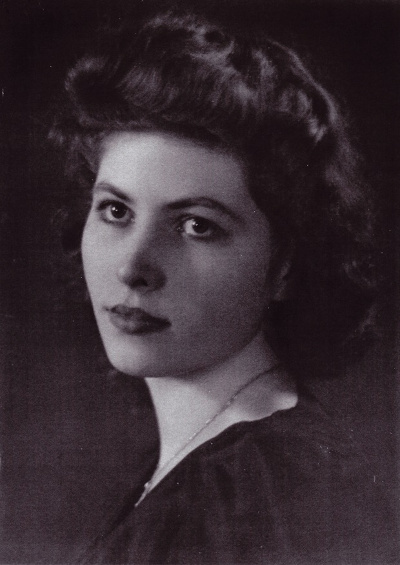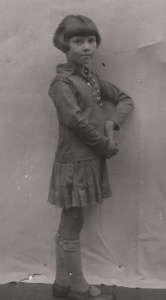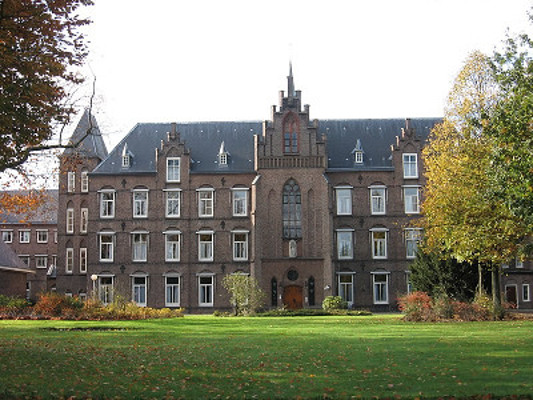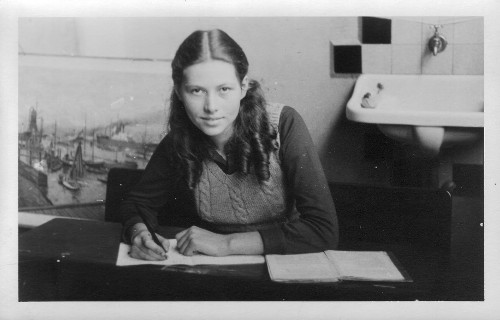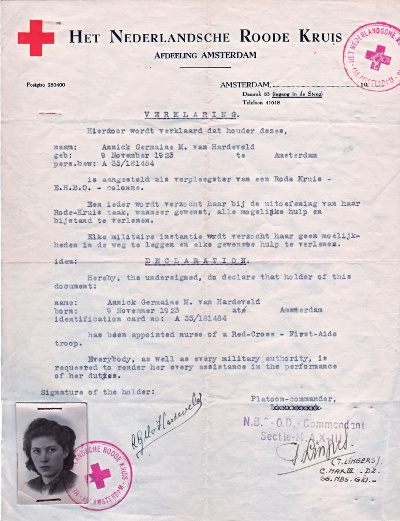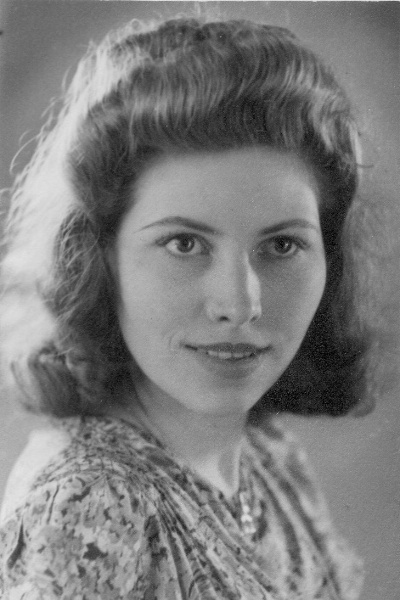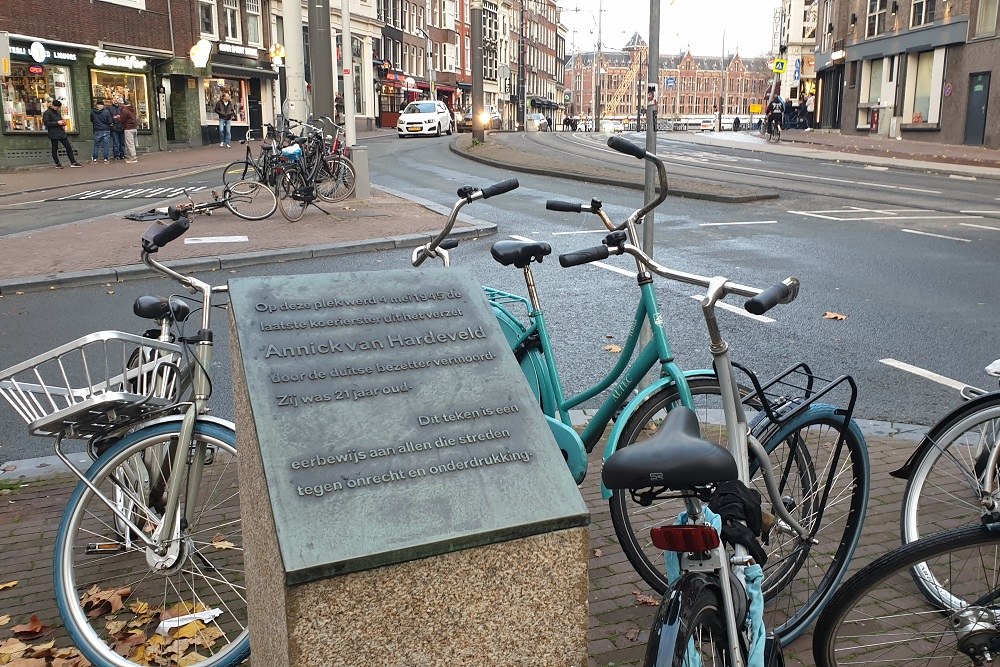Annick van Hardeveld (1923-1945)
Annick van Hardeveld was a courier in Amsterdam for the Nederlandse Binnenlandse Strijdkrachten (NBS; English: Dutch Domestic Armed Forces). In the night of May 4, 1945, Annick was travelling on her bike to the inner city of Amsterdam to deliver a message. On the Hekelveld, she was suddenly shot by a patrol of the Grüne Polizei. Annick was only 21 years old.
Definitielijst
- Grüne Polizei
- Green Police, nickname – due to their green uniforms – for the Ordnungspolizei (Order Policy) and which is the common denominator for local policy units tasked with exercising regular policy responsibilities during Nazi-Germany from 1936 to 1945.
A girl from Amsterdam with French charm
Annick was born in Amsterdam on November 9, 1923. Her full name was Annick Germaine Mathilde van Hardeveld. She had received the baptismal name ‘Germaine’ from her mother; the Frenchwoman Germaine Bertin. The name ‘Mathilde’ stemmed from her aunt. Several years later, her brother Yann Emile was born, and with his birth on September 17, 1927, the family was complete.
Annick and Yann’s father was Jan van Hardeveld, an architect with a successful architectural firm. Annick and Yann were raised bilingual, and together with their mothers’ family they spent many summers in the French coastal village of Dinard. In 1930, she first went to school. From 1934 to the end of 1936, she went to the boarding school Mariënburg in Bussum.
After she finished boarding school, Annick lived back home again and continued her education at the MULO (Meer Uitgebreid Lager Onderwijs, an education level comparable with middle school). While the outbreak of the Second World War came closer, France remained the preferred destination for holidays – often without her father Jan because of his work. On September 3, 1939, only two days after the German invasion of Poland, Annick and her family returned from France for the last time.
Definitielijst
- invasion
- Armed incursion.
Courier in the resistance
The now 18 years old Annick graduated from the MULO on July 20, 1942 and received her Mulo-A certificate. In November 1943, she received her First Aid certificate. Annick presumably joint the Dutch resistance in the same year. The group she became a member of was led by Tom Lingers, a pseudonym of Ton Schilling. Later, their division was called M III DZ-G10/NBS-SG, which stands for ‘group Max or Michiel III, in region 10 (Amsterdam), southern district, department Strijdend Gedeelte (English: Armed Forces) of the NBS.
Since Annick had received her First Aid certificate, she was able to get a document of safe conduct. This document proved that she worked as a nurse of the Red Cross, which meant that she could go outside after curfew. Like the other women in her group, this document enabled her to work as a courier. Every day, Annick travelled to the Wilhelmina Gasthuis, a hospital in Amsterdam, for her education or work. She possibly studied to be a nurse or medical analyst, but this is not clear yet.
Annick’s group C.-Max III (later known as C.-Michiel III) consisted of roughly 30 men and 10 young women. Annick transferred many messages as a courier, travelling with her bike or on foot, while dressed in a Red Cross uniform carrying her document of safe conduct. As a courier, she assembled people and spread warnings and instructions throughout Amsterdam. She and the other young women also smuggled ration cards, letters, and medicine, but also weapons and munition. This way, the other men would stand out less, reducing the risk of getting caught.
The communication headquarters was set up in an upper house on Valeriusplein 40, in which assignments were received by telephone. Two to three women were placed on stand-by, ready to execute incoming assignments. Every courier was also employed by approximately another five boys, for which the couriers would distribute messages. The parents of the girls often were unaware of their daughters’ employment in the resistance. This was also the case for Annick’s brother, who did not know anything of his sister’s actions until after the war. Their father, he speculated later, must have known all the time.
The commander described Annick as a shy young lady, eager to work on her own. One time, the commander hesitated to send Annick through the rain to deliver a message. Annick on the other hand, did not hesitate for a moment and immediately rode away on her bike. She told the commander that she wanted to do real work, rain or no rain.
Definitielijst
- resistance
- Resistance against the enemy. Often also with armed resources.
Her final trip
On May 4, 1945, the resistance group of Tom Lingers received an assignment to take out the German command post. The men of the group would gather the following morning in the Vossius Gymnasium to hand out weapons and give out instructions. To inform the men of this gathering, couriers were sent out at night, including Annick. She left her house on her bicycle to inform four men living in the north of Amsterdam of the forthcoming actions. However, Annick never reached the four addresses. Annick was shot on the Hekelveld by a patrol of the Grüne Polizei. She was hit several times and passed away. A resident of Hekelveld 3, was woken by the gunfire and wrote in his diary about the incident. According to the diary, Annick was shot at around 1:21 AM. Her bicycle was parked against a lamp post, which indicates that she might have stepped off before the incident. The bicycle was later taken away by a Dutch police officer. At around 3:10 AM, Annick’s body was picked up and removed by a cart.
Definitielijst
- Grüne Polizei
- Green Police, nickname – due to their green uniforms – for the Ordnungspolizei (Order Policy) and which is the common denominator for local policy units tasked with exercising regular policy responsibilities during Nazi-Germany from 1936 to 1945.
- resistance
- Resistance against the enemy. Often also with armed resources.
A dark Liberation Day
"During our travel through the city, we noticed little of the people celebrating the end of the war. Even though there were no trams or cars and there were people all around, it all went past us"
To Annick’s family, the long-awaited day of liberation was filled with great sadness. Annick was buried with honour on the Buitenveldert graveyard on May 11.
"She had to be there"
In 1946, Ton Schilling sent a letter to the parents of Annick. The letter contained a conversation Ton had had with Annick while she was on duty.
"I have spoken with Annick; long, very long, have we spoken together and something had grown, possibly exceeding human relations, because Annick had understood something which even my own fiancée, who was a courier as well, never understood; I mean that, despite all my anger towards the Germans, I hated this battle with everything I could, since the fantastical nature of my mind was not made for this destruction. This I had found in Annick as well; She who was born to be happy and to make happy too, she who had an outer as well as an inner beauty, which brought many, many of this loveless world to better thoughts and feelings. I have often blamed myself for accepting her as a courier, but I knew that if I didn’t take her into my group, she would have joined another group sooner or later, because she had to be there." (Letter from Ton Schilling, April 1, 1946)
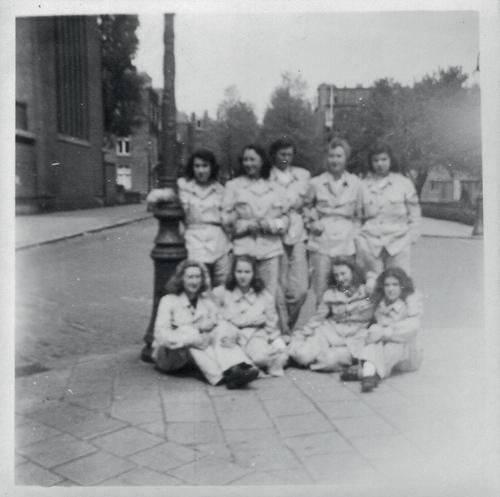
The couriers of Michiel III after the liberation, with an empty spot among them. Source: Annick van Hardeveld
On December 29, 1981, Annick was awarded the Resistance Memorial Cross posthumously. The medal was presented almost a year later, on November 6, 1982. A monument was revealed on May 4, 1985, in the presence of her mother, brother, and a few members of Annick’s former resistance group. The monument is placed on the Hekelveld, the location of her execution, to commemorate Annick and all who gave their lives for freedom.
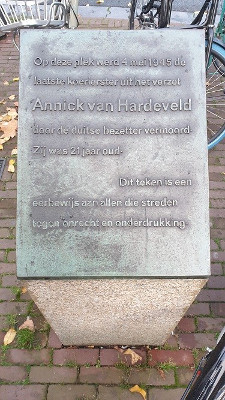
Monument at the location of Annick van Hardeveld’s execution. The text reads: On this spot, on May 4, 1945, the last courier of the resistance Annick van Hardeveld was killed by the German occupiers. She was 21 years old. This sign is a commemoration to all who fought against injustice and oppression. Source: TracesOfWar
Definitielijst
- Resistance
- Resistance against the enemy. Often also with armed resources.
Information
- Article by:
- Sanne Jussen
- Translated by:
- Thomas van der Veld
- Published on:
- 19-01-2025
- Feedback?
- Send it!
Related sights
Sources
- Oorlogsgravenstichting. Het levensverhaal van Annick van Hardeveld. Documentaire, 30-4-2015, geraadpleegd 5-11-2022
- We are very grateful to Annick van Hardeveld (a niece of the protagonist) for making the photos available.
Awards
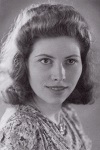
† May 4th, 1945
Plot: B Row: 1 Grave: 287

